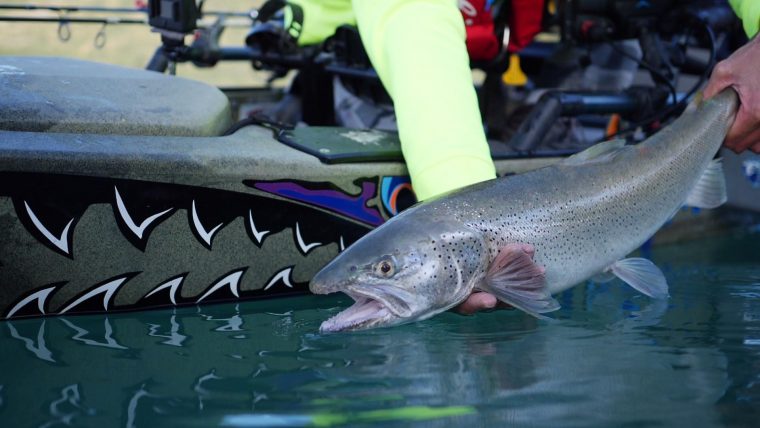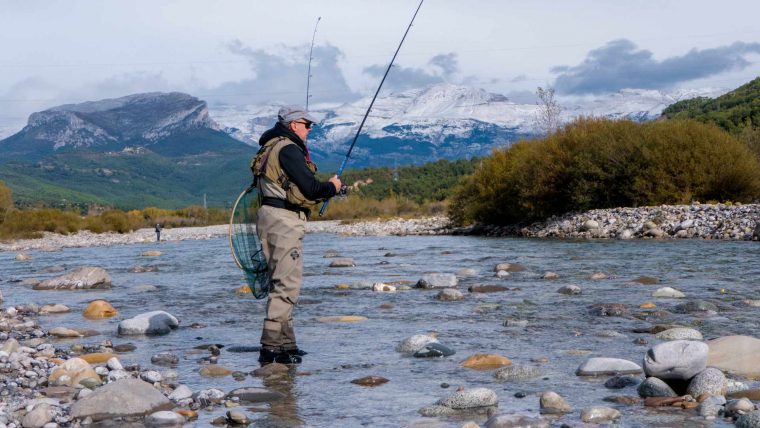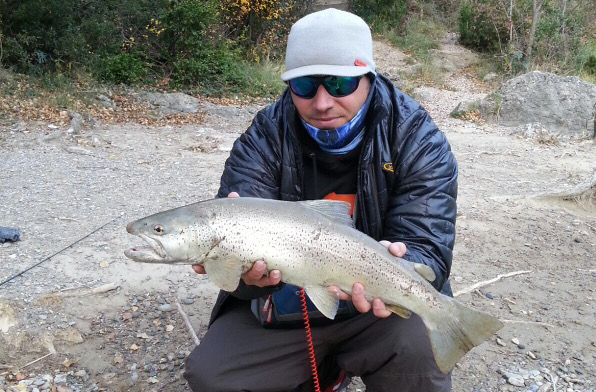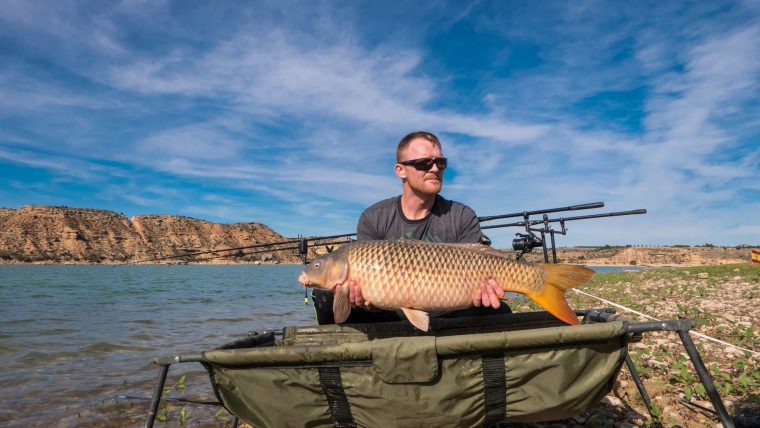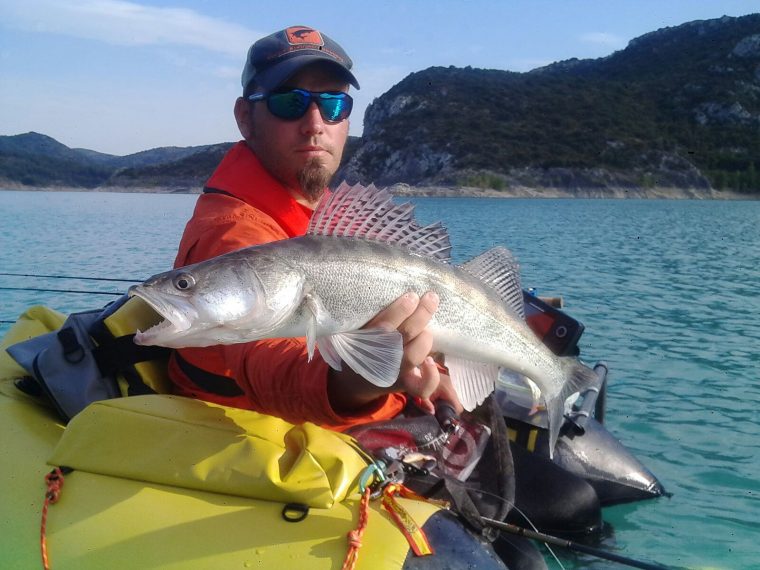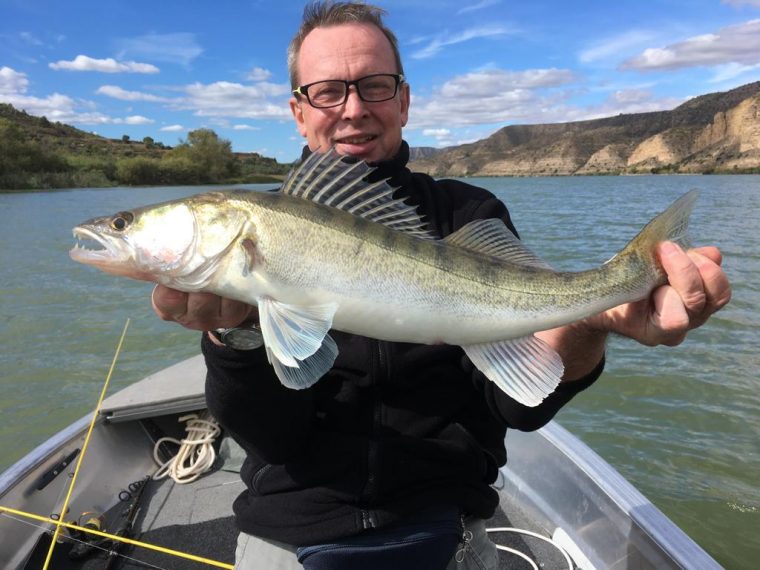The list of freshwater species present in Aragon is very extensive. The variety of natural ecosystems facilitates the conservation of autochthonous species whose endemic value and importance is incalculable.
They are generally rare populations of threatened cyprinids such as the Catalan barbel (Barbus haasi), blenidae such as the freshwater blenny,(Salaria fluviatilis) and many other small fish that we fishermen avoid, thus supporting their conservation and prosperity in our waters.
On the other hand, in more entropized ecosystems such as reservoirs, native species also threatened or in regression coexist in minority with new invasive species. This is the case of the South-west European nase (Chondrostoma Toxostoma), the Mediterranean Barbel (Barbus bocagei) or the Common Barbel of the Ebro basin (Barbus graellsii), which may occasionally be captured. In this case the immediate return of these specimens to the water is the best measure to be adopted by the fisherman.
We exclude these species to really focus on those that have greater catch possibilities and better sporting qualities for fishing.
Salmonidae
Common Trout
The undisputed queen of all the fast and oxygenated watercourses of Aragon is the Fario trout (Salmo trutta fario). t reaches remarkable sizes in a short time if the habitat conditions and food are favourable. They do not reach larger sizes due to the altitude in which they live and the ruggedness of their location. Its size, which easily surpasses 30 cm in any river, and which in favourable areas and moments can even reach 5 kg in a river, is not what characterises it because the true attraction of its fishing is its endemic and pure genetics.
The rivers are pampered and their populations reinforced with eggs deposited in “vivert boxes” so we always face wild trout born in the river itself.
n the places allowed by the fishing laws, generally in closed intensive fishing preserves and in extractive regime, is where only Rainbow Trout (Oncorhynchus mykiss).is repopulated. But all efforts are aimed at the preservation and empowerment of the common trout and there is always a minimum compulsory measure for capture to prevent the death of immature animals.
n the reservoirs there are still large trouts that surprise those who try to fish, and in the high mountain lakes there are Salvelinus – also called chars – (Salvelin us fontinalis) of precious livery and ferocious behaviour.
Exceptional places for their quality and abundance of specimens are: the Selva de Oza, the Valley of Bujaruelo, Benasque, the Sierra de Albarracín and other stretches of the Jiloca and Jalón Rivers.
Cyprinids
In Aragon there are several species of cyprinids: autochthonous, some such as barbels, ides or tench (or doctor fish) and others coming from crosses such as goldfish and others introduced such as the common dace (also known as Eurasian dace).
Carp
The common carp or European carp (Cyprinus carpio) is the cyprinid king of Aragonese waters as it inhabits virtually all of them. Although nowadays it is considered an alien (non-indigenous) and invasive species, it has been with us the cold of 2000 years, since it was the Romans who brought it. Throughout history has been extolled by all cultures and cultivated as a means of sustenance, raised in ponds as ornamental fish, and lately considered one of the most sporting fish and sought by the modern fisherman.
In Aragon the carp that populate the rivers are generally wild genetics and very adapted to the currents. They can be distinguished by their darker, almost black livery. They are mostly of the common variety or completely scaly, with beautiful copper, gold and orange tones. In the reservoirs they are more varied and the royal carp is also very frequent.
What makes the carps you will find here different is that they are plump, tight, and gluttonous and reach very considerable weights. These waters were characterized a few years ago by containing too many carp, almost meant a plague in some places, and did not increase in size or there were good specimens because the competition for food was such that their sizes never prospered. To this was added the lack of natural predators, but this changed with the arrival of the catfish. Because it preys on them, but this heals their populations, produces a natural selection, and in this way the ecosystem has improved in balance.
Currently, the number of carps in the Ebro reservoirs is lower, but it is populated by healthy specimens, which grow adequately to previously unimaginable sizes, equipping their growth rate to that of the best European lakes. We take great care of the carp of Mequinenza and Ribarroja because their sizes are what make them attractive for the angler. The average size of the catches is about 16 kg, and those of more than 20 kg are very frequent. The official record carp have reached 32 kg in Mequinenza and Ribarroja.
They are very travelling fish that move through different areas of the reservoir depending on the season of the year. These carp are very appreciated in the rest of Europe for their reputation as fighters thanks to their large fins and longer length. The specialized technique for their capture is carp fishing, in which respect for the capture and their subsequent return to the water are its fundamental pillars. As it is a technique widely practiced in Europe by fishermen who travel many different lakes behind it.
Mequinenza and Ribarroja have become one of the best destinations on the circuit for big carp fishing. After them there are many competitions and the 2015 World Cup was held here.
Large predators
Blackbass
The blackbass (Micropterus salmoides) although not the largest here, is always the most sought after of all predators and the most veteran of the species now present in Aragon. This North American fish was introduced into the Mequinenza Reservoir in 1955 and legally as well as in other waters of the Iberian Peninsula.
t is almost always fished from a boat. It prefers calm and clear waters with aquatic vegetation and inhabits inaccessible areas of reservoirs. His fishing is very sportive because of his fighting character, with strong bites, races and spectacular jumps and most of the competitions in Aragon are dedicated to it.
It reaches a size of about 4 kg although the average weight is usually about 2 kg. It is greatly affected by the prevailing climate, the conditions of the environment and the time of year. Although great fish are fished at certain times, the basses from Aragon stand out for their distrust and difficulty and represent a challenge for the best. Japanese and especially Americans, true discoverers of this fishery here, still enjoy these waters as a permanent testing ground for their techniques and lures.
It is mainly present in the sports reserves of Ribarroja and Mar de Aragón in Zaragoza, in the Santolea and Calanda Reservoirs in Teruel, and in the Santa Ana, Canelles, Mediano and Escales Reservoirs in Huesca. It also inhabits small lakes and ponds to a lesser extent.
Northern Pike
Another predatory fish, very sporty and appreciated in Europe and that reaches considerable sizes is the pike (Essox Lucius). Although it was the only Iberian predator after its legal introduction in 1949, here it has suffered greater competition with other new ichthyophagist species, and given that it is affected to a greater extent by the degradation of the environment, it is in frank regression. As its current presence is so uncertain and scarce, it is not considered as a first-rate sport species and we can avoid its fishing.
Perch
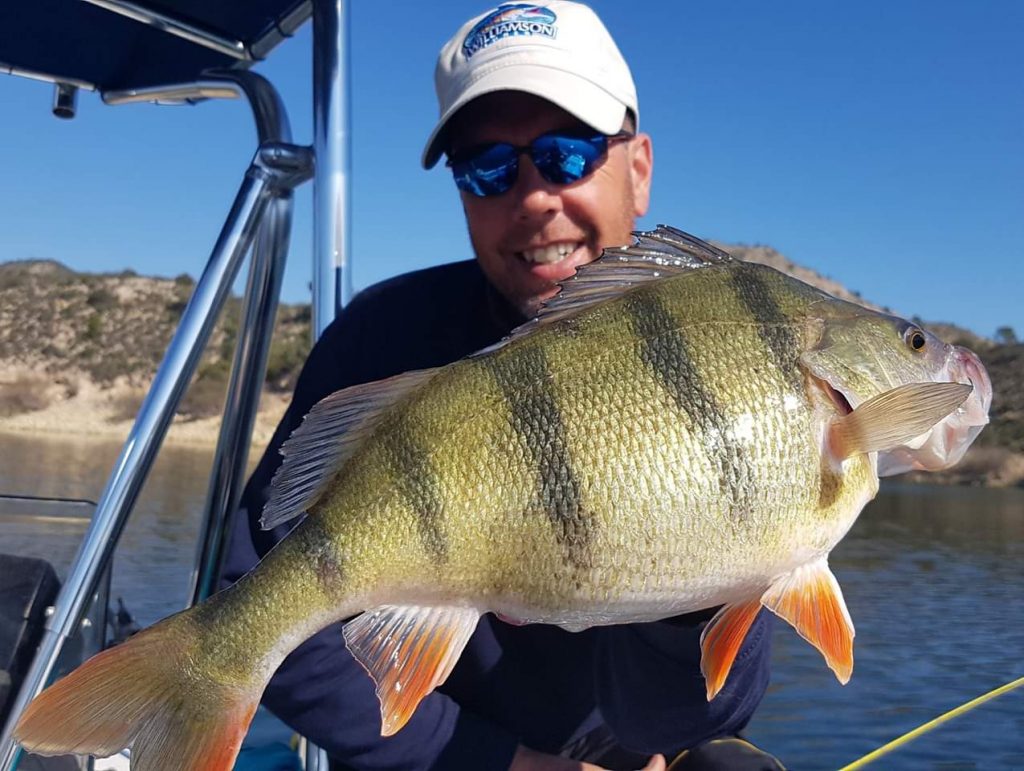
The European perch (Perca Fluviatilis) has revolutionised lure fishing in these waters in a very short time. It is a medium sized predator, which has a typically perceptible morphology, is endowed with vertical orange bands along its flanks that clearly differentiate it from other Percids. This predator is characterized by its mobility, voracity, and ability to adapt to the environment as it coexists perfectly among other predators.
It was the last foreign species to appear in Aragonese waters. Not more than 15 years ago and has acclimatized perfectly. It occupies different places of the reservoir depending on the conditions, almost always grouped in schools, sheltered in important depths and calm waters. It reaches heavier weights than in its European waters of origin and is a coveted prey by many fishermen. It easily reaches 3 kg and is still in full expansion.
Although finding them is not easy, once located the bites are numerous and their fishing is one of the most grateful given their eagerness to bite and their combativeness to be caught.
The Perch lives almost exclusively in the Mequinenza and Ribarroja reservoirs, where its fishing is already very popular and complements great fishing adventures.
Zander
The zander (Sander Lucioperca) is a strong fish with an elongated body and crowned by a good sized double spiny dorsal fin. It has a powerful head, with strong jaws and four tusks which are its distinctive feature. Predator of nocturnal habits in which his eyes also stand out, big and with a magnificent vision and that allow him a greater absorption of light even in great depths.
It is currently the largest perch in the waters of Aragon, having been found in the reservoir of Ribarroja catches near 12 kg and a size greater than one meter in length. The average size is 2 or 3 kg and depending on the banks located their catches can be very numerous. French fishermen who are its great connoisseurs say that here can reach the largest dimensions of Europe and define it as a fish with a very delicate and powerful bite, and their insistence fishing in our waters can certify this.
Its origin is Central European and it was introduced in Catalonia in the 80’s arriving to Aragón illegally, suddenly appearing in many waters.
At present its presence is very much localized almost exclusively in the great reservoirs of stony depths. The largest specimens are probably fished in the Ribarroja Reservoir, but the species has also acclimatised perfectly to cold waters, or at least deep and with a slight current, which are its most favourable habitats. It is very common in the Sea of Aragón, and also in reservoirs in the province of Huesca such as Mediano, La Sotonera or Santa Ana.
Wels catfish (also called sheatfish)
Defining the current role of the wels catfish in this region means recognizing it as the great protagonist and true ambassador of our fishing abroad. The anglers eager for strong emotions who visit us do so by looking for the wels catfish. Around their fishing a strong infrastructure has been created in the Ribarroja and Mar de Aragón Reservoirs.
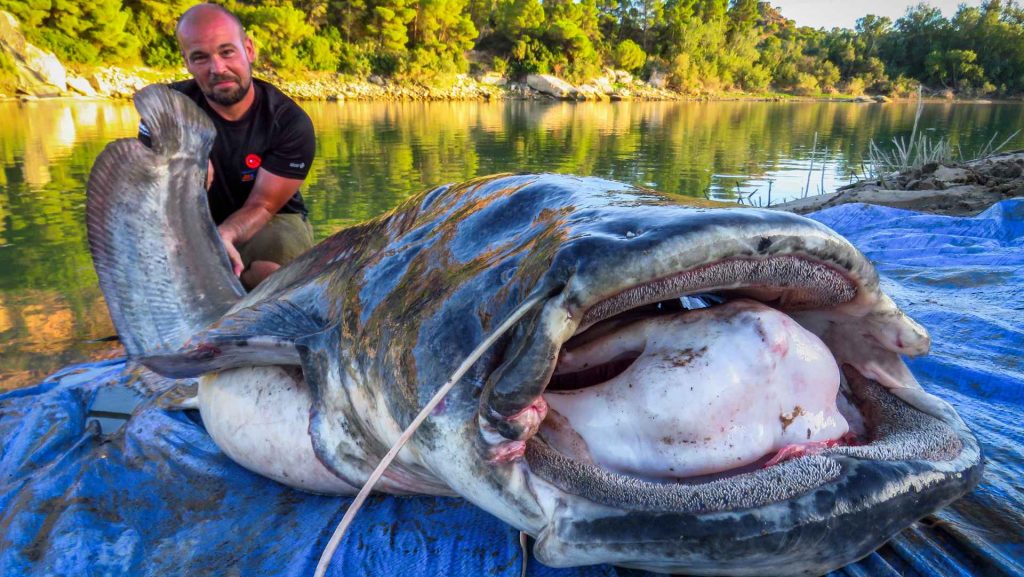
The Wels Catfish (Silurus glanis) is a species native to the great rivers of Central Europe that has spread outside its natural area. Spain has been one of the countries where its acclimatization has taken place in a faster and more prolific way. Since its intentional and illegal introduction into the Segre River and the Ribarroja Reservoir in 1974, it has progressively expanded along the Ebro River, colonising its tributaries and reservoirs. Its rapid adaptation is due to its own nature, so resistant and so well adapted to the environment. Warm waters and mild winters favour its rapid development.
It reaches considerable dimensions not found in northern Europe. The record is in Ribarroja with a specimen 2.63 metres long and weighing more than 120 kg.
Its fishing is a very exciting and attractive activity because in certain places of the Ebro River the wels catfish is very abundant, and especially in THE Ribarroja and Mequinenza Reservoir. The average size of catches is around 2 meters long.
It is a very stealthy fish, with slow movements and even long moments of inactivity, but at the same time its uprooting is fast and very powerful. Its body is very elongated, snake-like, muscular and without scales, with a wide and flattened head. Its tiny eyes are of little use to him, since with his long whiskers and lateral line the wels catfish registers any kind of vibration no matter how slight it may be. For this reason it is an expert hunter in muddy or swampy waters. The wels catfish alternates the greater depths with other very shallow areas where with he hunts all kinds of prey in a characteristic and even audible way his oversized mouth.
Over the years, those first demographic explosions that colonized so many bodies of water have given way to a smaller population of small catfish. They are also positioned in specific areas coexisting with other species in harmony and their presence has been reduced. However, its development here has proved to be the largest and fastest of all, surpassing the sizes that reach in large European rivers such as the Rhine, Po and Danube where this species has its cradle.Specialists dedicated to catfish fishing visit and know this privileged enclave. Everyone wants to measure his strength with these Aragonese giants.
The main places for their fishing are the Sea of Aragón, Ribarroja and the Ebro River.

